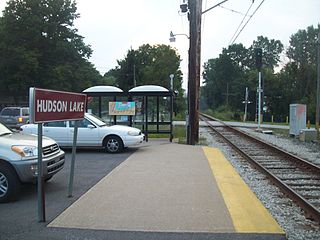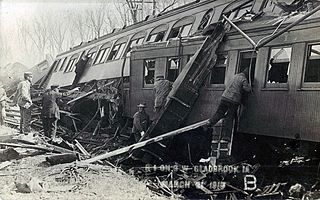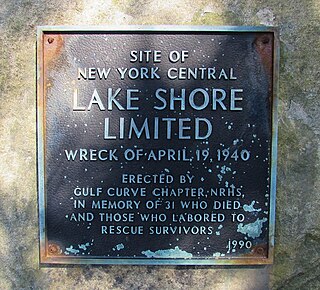
Mishawaka is a city on the St. Joseph River, in Penn Township, St. Joseph County, in the U.S. state of Indiana. The population was 51,063 as of the 2020 census. Its nickname is "the Princess City". Mishawaka is a principal city of the South Bend–Mishawaka, IN-MI, Metropolitan Statistical Area.

A collision between two commuter trains in Chicago occurred during the cloudy morning rush hour on October 30, 1972, and was the worst such crash in Chicago's history. Illinois Central Gulf Train 416, made up of newly purchased Highliners, overshot the 27th Street station on what is now the Metra Electric Line, and the engineer asked and received permission from the train's conductor to back the train to the platform. This move was then made without the flag protection required by the railroad's rules. The train's crew had not used a flagman before, and while it was a prescribed practice, it had fallen out of use. Instead, the conductor and the engineer worked in concert to back up the train, with the curve in the track partially blocking the view.

Hudson Lake is a train stop operated by the South Shore Line in the unincorporated community of Hudson Lake, Indiana. It is one of a very few interurban stations located in a rural region of the United States, being located approximately halfway between the much larger communities of Michigan City and South Bend. The station is composed of a passenger shelter, a sign, a small concrete pad, and a small parking lot.

East Chicago is a train station at 5615 Indianapolis Boulevard in East Chicago, Indiana. It serves the South Shore Line commuter rail line from Chicago, Illinois to South Bend, Indiana.
The Morelos railway accident occurred on 23 June 1881 near Cuautla, Morelos in Mexico when an entire train plunged into the San Antonio river, killing over 200 people.

The Angola Horror train wreck occurred on December 18, 1867, just after 3 p.m. when the last coach of the Buffalo-bound New York Express of the Lake Shore Railway derailed at a bridge in Angola, New York, United States, slid down into a gorge and caught fire, killing approximately 49 people. At the time, it was one of the deadliest train wrecks in American history.
The Connellsville train wreck was a rail accident that occurred on December 23, 1903, on the Baltimore and Ohio Railroad near Connellsville, Pennsylvania. The Duquesne Limited, a passenger train, derailed when it struck a load of timber lying on the tracks. The timber had fallen from a freight train minutes before the collision. The crash resulted in 64 deaths and 68 injuries.
The 1906 Washington, D.C., train wreck occurred on the Metropolitan Branch of the Baltimore and Ohio Railroad (B&O) at Terra Cotta station in Washington, D.C., on December 30, 1906, at 6:31 in the evening, when a locomotive pulling six empty cars crashed into the back of a passenger train in dense fog, killing 53 people and injuring more than 70.

The Green Mountain train wreck is the worst ever railroad accident in the state of Iowa, USA. It occurred between Green Mountain and Gladbrook on the morning of March 21, 1910, and killed 52 people.
The Custer Creek train wreck is the worst rail disaster in Montana history. It occurred on June 19, 1938 when a bridge, its foundations washed away by a flash flood, collapsed beneath Milwaukee Road's Olympian as it crossed Custer Creek, near Saugus, Montana, south-west of Terry, killing at least 47 people.

The Corning train wreck was a railway accident that occurred at 5.21 a.m. on July 4, 1912, on the Delaware, Lackawanna and Western Railroad at East Corning freight station in Gibson three miles east of Corning in New York State, leaving 39 dead and 88 injured.

A train crash with fatalities occurred shortly after 11:30 p.m. on April 19, 1940, when a first-class westbound Lake Shore Limited operated by the New York Central Railroad, derailed near Little Falls, New York, United States. The accident was later found to have occurred due to excessive speed on the Gulf Curve, the sharpest on the Central's lines. It killed 31; an additional 51 were injured.

On August 12, 1939, the City of San Francisco train derailed outside of Harney, Nevada, United States, killing 24 and injuring 121 passengers and crew. The derailment was caused by sabotage of the tracks. Despite a manhunt, reward offers, and years of investigation by the Southern Pacific Railroad (SP), the case remains unsolved.









